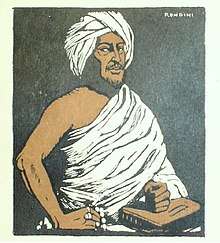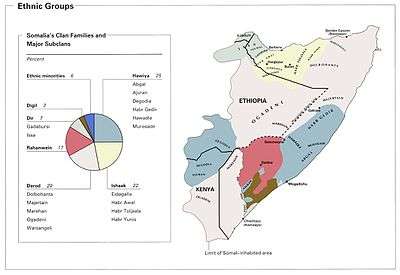Ogaden (clan)
The Ogaden (Somali: Ogaadeen, Arabic: أوغادين) is a Somali clan family, part of the largest Somali clans-family — the Darod.[2][3][4]
| Total population | |
|---|---|
| 697,566 (Kenya)[1] | |
| Regions with significant populations | |
| Languages | |
| Somali | |
| Religion | |
| Islam (Predominantly Sunni, Sufism) | |
| Related ethnic groups | |
| Jidwaq, Absame, Marehan, other Darod family clan, and other Somali clans |
Overview

Members of the Ogaden clan primarily live in the central Ogaden plateau of Ethiopia (Somali Region),[5] the North Eastern Province of Kenya, and the Jubaland region of Southern Somalia.
According to Human Rights Watch, the Ogaden is the largest Darod clan in Ethiopia's Somali Region, and may account for 70 to 80 percent of the Somali population in Ethiopia.[6] The Ogaden clan "constitutes the backbone of the ONLF".[7] In particular, the ONLF operates in Ogaden areas[8]
Frank Linsly James, one of the first Europeans to travel deep into Ogaden territory while being accompanied by Lord Philips and armed with Martini-Enfield rifles, describes his first encounter with Ogadens in 1884.
After marching for six hours, we were joined by two Ogadayn natives, who said they would show us the wells, which were close at hand. They pointed to our guns and asked their use. When we said, "for killing men and beasts," they laughed, and replied " they would be no use against sticks, let alone swords and spears." A Hornbill was sitting on a tree listening to this conversation, and echoed the natives' laugh with an assenting croak of scorn. Lord Phillips raised his despised firearm, and down fell the lifeless hornbill. Down, too, fell the Ogadayn natives, and remained for some time with their faces pressed against the ground, invoking the protection of the great Allah. [9]

.
Notable persons
- Mohammed Abdullah Hassan, the Sayyid; religious and nationalist leader of the Dervish movement; called the Mad Mullah by the British
- Sheikh Abdulkani Sheikh Ahmed (Buraale) Aw Adam, Minister of Justice and Religion[11], Somalia from 1970 to 1972
- Mahamoud Mohamed Former Chief of General Staff of the Kenya Defence Forces from 1980 to 1998.
- Admiral Mohammed Omar Osman, current ONLF chairman
- Bashir Bililiqo, leader of the anti-Barre Somali Patriotic Movement
- Asli Hassan Abade, first Somali female pilot
- Farah Maalim, former Deputy Speaker of the National Assembly of Kenya
- Aden Duale, the majority leader of the Kenyan parliament
- Hassan Abdullah Hersi al-Turki, Islamist leader in Somalia and military leader in the Islamic Courts Union
- Mohamed Yusuf Haji, former Minister of Defence and acting Minister of Internal Security and Provincial Affairs in Kenya
- Nuruddin Farah, renowned writer and winner of the 1998 Neustadt International Prize for Literature
- Ahmed Madobe, President of Jubbaland, chairman of the Raskamboni movement
- Mohamed Dheere, Fighter in Juba River, and mentor of Ahmed Madoobe.
- Hassan Abdillahi, founder and President of Ogaal Radio
- Aden Duale, current Majority Leader in the Kenyan Parliament
- Abdirahman Ali Hassan, Wajir county senator and the deputy minority leader in the senate house from 2013-2017, assistant minister of trade 2005-2007, Wajir south constituency MP, 2002-2013
- Aar Maanta, a Somali-British singer-songwriter, actor, composer, instrumentalist and music producer.
- Ahmed Gurey
References
- "2019 Kenya Population and Housing Census Volume IV: Distribution of Population by Socio-Economic Characteristics". Kenya National Bureau of Statistics. Retrieved 24 March 2020.
- "Somalia: Minorities and indigenous peoples". Minority Rights Group International. Retrieved 18 September 2019.
- Lewis, Ioan M (1999). A Pastoral Democracy: A Study of Pastoralism and Politics Among the Northern Somali of the Horn of Africa. James Currey Publishers. p. 12. Retrieved 18 September 2019.
- Lewis, Ioan M (July 1959). "Clanship and Contract in Northern Somaliland". Africa: Journal of the International African Institute. 29 (3): 274. Retrieved 18 September 2019.
- "Collective Punishment", p. 14
- "Collective Punishment", p. 13
- "Collective Punishment", p. 4
- "Collective Punishment", p. 27
- The Unknown Horn of Africa: An Exploration From Berbera to the Leopard River, By Frank Linsly james, p.104
- "Somalia Maps - Perry-Castañeda Map Collection - UT Library Online". Retrieved September 21, 2019.
- "Brief history – Ministry of Justice and Judiciary Affairs : Federal Government of Somalia". Retrieved 2019-08-23.